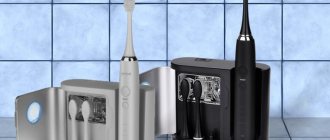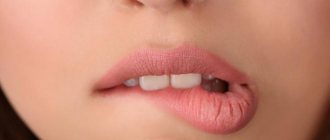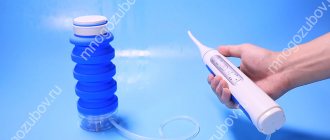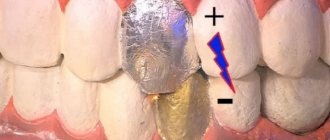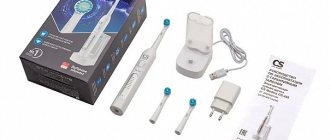According to many dentists, an irrigator is not only an indispensable device for thorough cleaning of the oral cavity, but also an excellent assistant in the prevention of dental diseases.
The modern market is filled with models of stationary and portable irrigators - it is up to the buyer to decide which one is better to choose.
A detailed review and rating of new and proven devices that have earned high marks from experienced users and experts will help you understand the features and differences of devices.
Why do you need an irrigator?
- For the prevention of caries. The irrigator helps get rid of plaque on the teeth and tongue. It also cleans hard-to-reach places - molars, wisdom teeth, interdental spaces and orthodontic structures.
- For the prevention and treatment of gum diseases. The irrigator improves blood circulation in the gums and accelerates the regeneration process. This helps strengthen them and reduce bleeding.
- For the care of implants, crowns, bridges, braces and other structures. The irrigator rinses them and the cavities behind them.
- To eliminate the causes of bad breath.
- For the prevention of gingivitis. The disease can occur in pregnant and lactating women due to deterioration of blood supply to the mucous membranes.
There are no contraindications to using the irrigator.
Waterpik WP 450
The veteran of the fight against bacterial plaque, Waterpik WP 450, closes the top five most popular portable irrigators. It is preferred by conservatives who value stability and tradition. The model fully meets these needs. An easy-to-use and reliable model of stars from the sky is in short supply, limited to modest technical indicators and a respectable price.
Sliding power and mode switches evoke real nostalgia among connoisseurs of retro style. There are only two modes, designated by Roman numerals I and II. But the set includes four interchangeable nozzles:
- Standard;
- Orthodontic;
- For implant care;
- For cleaning the surface of the tongue.
The case is made of high-quality plastic that is protected from moisture. The installed nozzle is securely fixed, there is no play or leakage.
OLEG ILYASHENKO
Types of irrigators
Irrigators are stationary and portable. For home use, it is better to choose a stationary one - it is more reliable and will last longer. Some of them can be mounted on the wall. This is useful if you have limited sink space.
If there is no outlet in the bathroom, you can choose a portable irrigator - it runs on a battery and can be charged anywhere. A portable irrigator is lighter and smaller than a stationary one - it is convenient to take it on trips.
The first important parameter for choosing an irrigator is the power of the water jet. A portable irrigator must have a power of at least 520 kilopascals (kPa), and a stationary one must have a power of at least 550 kPa. The second selection parameter is the number of jet pulsations per minute. The optimal value is 1200 pulsations.
Irrigators also differ in their mode switching system. For stationary ones, mode switching occurs smoothly, for portable ones - stepwise. If the waterpik is used by children or people with gum disease, it will be more difficult for them to adjust the comfortable power on a portable one.
Comparison of popular models
To help you make the right choice, we have prepared comparison tables of stationary and portable irrigators. The tables list all the important characteristics of the devices.
Stationary irrigators
| Waterpik WP-100 E2 Ultra | Revyline RL 100 | Waterpik WP-660 Aquarius | Revyline RL 500 | Aquajet LD-A8 | B.Well WI-922 | Donfeel OR-820D Compact | Donfeel OR-840 AI | CS Medica AquaPulsar CS-2 | |
| Tank volume, ml | 650 | 600 | 650 | 600 | 500 | 600 | 600 | 600 | 500 |
| Number of nozzles | 7 | 7 | 7 | 7 | 5 | 7 | 8 | 5 | 5 |
| Guarantee | 2 years | 2 years | 2 years | 2 years | 1 year | 2 years | 1 year | 1 year | 2 years |
| Power | from 70 to 690 kPa | from 210 to 870 kPa | from 70 to 690 kPa | from 210 to 870 kPa | from 290 to 810 kPa | from 207 to 827 kPa | from 100 to 650 kPa | 80 - 680 kPa | from 150 kPa to 850 kPa |
| Number of pulsations, min | 1400 | 1200-1700 | 1400 | 1200-1700 | 1200 | 1250-1850 | 1250 — 1550 | 1250 — 1700 | from 1100 to 1600 |
| Wall mount | No | No | No | No | There is | No | No | No | There is |
Portable irrigators
| Waterpik WP-450 | Revyline RL 450 | Philips Sonicare AirFloss Ultra HX8381/01 | Panasonic EW-DJ40 | Panasonic EW1211A | Revyline RL 200XL | B.Well WI-911 | B.Well WI-912 | CS Medica AquaPulsar CS-3 Basic | |
| Tank volume, ml | 210 | 240 | 15 | 165 | 130 | 300 | 150 | 150 | 130 |
| Number of nozzles | 4 | 5 | 1 | 1 | 2 | 2 | 2 | 5 | 2 |
| Guarantee | 2 years | 2 years | 2 years | 2 years | 2 years | 2 years | 1 year | 1 year | 2 years |
| Power | from 310 to 520 kPa | from 130 to 760 kPa | 390 and 590 kPa | from 200 to 590 kPa | from 210 to 700 kPa | 275 - 620 kPa | 378 - 720 kPa | up to 590 kPa | |
| Number of pulsations, min | 1450 | until 1700 | 1400 | 1400 | 1400-1800 | 1600 | 1420 | 1200 — 2000 |
The best irrigators
To choose a convenient, suitable irrigator for yourself, you should familiarize yourself with the technical data, user reviews and prices of the devices. The data is arranged in the table in the following order.
| Device name | Description, advantages and disadvantages | Price |
| Waterpik VP-100 Ultra | It has 10 operating modes, strong jet pressure, adjustable, silent operation, many attachments, disadvantages: short cord, no bracket for storing it on the wall, high price. Stationary type, made in the USA. | 6600 rubles |
| Aquajet LD-A7 | High pulsation frequency, high jet pressure, there is a storage bracket, long operating time, no cons. Type stationary, manufacturer Singapore. | 3000 rubles |
| Matwawe Clean Pro V-20 | Large water capacity, adjustable pressure, 10 speed modes, many attachments, no downsides except the price. Stationary type, made in the USA. | 10,000 rubles |
| Panasonic EWDJ-40 | Compact, holds a charge for a long time, disadvantages: low power. Portable type, made in Japan, assembled in China. | 4500 rubles |
| Jetpik JP-50 Travel | Induction charging, cleaning not only with a jet of air, but also with dental floss, there are no downsides. Portable type, made in the USA together with China. | 8800 rubles |
| Shenzhen Fortunecome Technology FL-V8 | Three air supply modes, 25 minutes of continuous operation, lightweight, beautiful design, disadvantages: only two nozzles are included. Portable type, made in China. | 3100 rubles |
| Oral-B Professional Care OxyJet MD20 | Cleans plaque and massages gums, has a high water flow rate, works for 15 minutes, long cord, no downsides. Stationary type, made in Germany. | 7200 rubles |
| Panasonic EW-1211A | In operation, the head rotates, induction charging, lightweight, rubberized body, disadvantages: small water container, requires filling 2 times per cleaning. Portable type, made in Japan, assembled in China. | 5200 rubles |
| Donfeel OR-820D Compact | Light weight, affordable price, charge lasts 12 days, there is a container for attachments, disadvantages: weak air pressure. Portable type, manufactured in Russia. | 3500 rubles |
| Oral-B Profession Care OxyJet+3000 | Multifunctional, good storage container, designed for the whole family. Cons: expensive. Type stationary dental center (electric brush + irrigator), made in Germany. | 14,000 rubles |
Top 10 best models according to the Techrevizor channel:
Nozzles and their types
The irrigator comes with one or more attachments. Remember that each family member should have their own. Nozzles can be purchased and changed. Here are the types of attachments:
- The standard brush head is suitable for cleaning healthy teeth and gums.
- An orthodontic attachment is needed to remove plaque under braces and under the gingival margin. For these purposes, you can use a standard attachment, but the orthodontic one is more convenient.
- A periodontal nozzle with a thin soft rubber tip directs the jet beyond the gingival margin and into the periodontal pocket. It cannot be used at maximum power.
- The plaque remover is effective for treating implants, crowns and bridges. At its tip there are 3 tufts of bristles.
- The tongue cleaner removes plaque from the tongue and cheeks, eliminating the cause of bad odor.
- For additional plaque removal there is a brush attachment. But it cannot replace a regular toothbrush.
- A nasal nozzle is needed to irrigate the nasal cavity during the treatment or prevention of rhinitis and sinusitis.
A standard waterpik head should be replaced approximately every six months, while periodontal, orthodontic and brush heads should be replaced every three months. Remember that each family member should have their own nozzle.
Types of irrigators
Differences in design
Stationary
The design is large, not suitable for frequent transportation due to its size and power connection. Depending on the volume of the container, it can be individual or family, used by several people; for this purpose, the kit includes attachments with different color markers.
Portable
This is a mobile irrigator that runs on battery power. The water tank is small, but its volume is enough for cleaning one time. The jet pressure is much lower than in stationary ones. Convenient for travel or when used by one person. The cost is higher, but the equipment is minimal.
From the water supply
The design is simpler than the previous ones. It is connected to a water supply tap and operates from its pressure, therefore it does not have a container for liquid. The disadvantage of the design is the inability to use liquids other than water. It is difficult to regulate the water pressure and, most often, there is a complete lack of modes.
According to the operating principle
Irrigators are divided into categories based on the principle of supplying a stream of water. 80% of irrigators on the market are pulsed.
Pulse
Creates water hammer with a thin stream of water, the number of pulses is from 1200 per minute or more, depending on the model. Microscopic hydraulic shocks increase the effectiveness of removing plaque from teeth. We recommend it to people susceptible to gingivitis and periodontal disease.
Pros of a pulse irrigator:
- The impulses do not cause discomfort.
- Performs a massage of soft tissues, improves blood flow in them.
- Highly effective in removing old and fresh plaque in the space between teeth and in the postmolar area.
Minuses:
- Requires frequent replacement of attachments.
Microbubble
Most dentists call this technology the most effective. It works on the principle of saturating the supplied water stream with air bubbles. This mixture effectively removes all food debris from the interdental space, removes plaque, and reduces the number of pathogenic bacteria in the mouth. Models with microbubble supply operate in soft and standard operating modes and differ in the strength of the supplied jet. Can be used for washing the nasopharynx and nose, treating periodontal disease, gingivitis, periodontitis.
Pros:
- Special attachments strengthen gum tissue and stop the development of various diseases.
- Excellent for cleaning crevices between teeth and gum pockets.
- Antibacterial effect due to air bubbles.
Minuses:
- Cannot be used for periodontitis.
- The price is 30% higher compared to impulse.
Monojet
Design with connection to the water supply system, which ensures a constant flow of water, the pressure is maintained by the water supply system. This is an adapter for a faucet with a hose that turns into a handle with a nozzle. Since there is no container for pouring the necessary liquid, a special capsule with antibacterial liquid may be included with the device. Monojet effectively fights the occurrence of various diseases of teeth and gums.
Pros:
- Simplicity of the design itself and its use.
- Low cost.
- Can be used without a power source.
- Combating gum and dental diseases.
Minuses:
- Low efficiency compared to the previous two.
- Installation on the tap before each use, not in all models.
- Demanding about the quality of tap water.
- No modes.
- Difficult to regulate pressure.
- Morally outdated.
Balms for irrigator
The use of special balms for the irrigator can enhance the effect of the procedure, as their components have antibacterial and anti-inflammatory properties. The choice of liquid depends on your goals. Some liquids help strengthen enamel, others are effective against inflammatory gum diseases, and others have a complex effect. On our website you can buy liquids for irrigators from the companies Donfeel, Professor Persin, Albadent and Iriks. The store also has profitable sets of several bottles.
How to choose a liquid for an irrigator
When choosing a liquid for an irrigator, you should take into account its composition and purpose. You should not pour running water into the irrigator - it may contain impurities harmful to the enamel. Depending on the active substances, solutions can be intended for:
- Strengthens enamel due to fluoride content.
- Treatment and prophylactic purposes. This rinse usually contains antiseptics and herbal extracts.
- Fresh breath. The composition usually includes mint, menthol or eucalyptus.
- Treatment of periodontal disease - contains bioantioxidants and anti-caries additives.
Allergy sufferers are advised to choose hypoallergenic balms.
How to choose a liquid for an irrigator
Which irrigator liquid is best? This question cannot be answered unambiguously. Each formulation is designed specifically to address specific dental problems. For example, liquids with a wound-healing and antiseptic effect are suitable for treating gums prone to bleeding, and formulations with fluoride and calcium are suitable for cleaning teeth with increased sensitivity.
It should also be remembered that professional formulations are not suitable for home use. Such products have contraindications, so treatment is carried out only under the supervision of a dentist.
If a patient has a tendency to allergic reactions, he is prescribed hypoallergenic balms with the most neutral composition. For children, you should choose products that do not contain alcohol.
To avoid complications, when choosing a liquid for an irrigator, it is recommended to consult a dentist. This rule applies to both therapeutic and prophylactic agents.
Irrigator care
Here are a few rules for caring for irrigators:
- Do not touch the charger with wet hands;
- Do not allow the device connected to the network to come into contact with water;
- Carefully monitor the integrity of the cord;
- Do not wipe the case with alcohol;
- The device should not be located near heating devices;
- Fill the reservoir only with water and special balms for the irrigator;
- While the irrigator is operating, do not hold the pause button for long - the motor may burn out;
- Use only attachments recommended by the manufacturer;
- If you take the waterpik on the road in winter, there should be no water in it - otherwise it will freeze and the device will break. To remove all the water, turn on the irrigator and let it run until all the liquid comes out.
How often should you use an irrigator?
Considering that this device is used as an auxiliary measure and does not replace standard cleaning, the frequency of use should be chosen depending on the general condition of the oral cavity of each person.
It is believed that it is correct to carry out this treatment every time after eating. It is clear that due to certain circumstances, this is practically impossible. In this regard, cleaning 2 times a day will be sufficient.
First you need to brush your teeth very well, carefully treating each one separately. After this, you can proceed to rinsing the oral cavity with an irrigator. The final stage will be massaging the gums with water. It is better to apply more pressure to achieve the best results.
If everything goes well during the first 2 weeks, then use of this product can be continued and the number of procedures can be reduced to 4-5 per week. If any problems arise, you cannot put off visiting a doctor and you must stop using it.
It is prohibited for use by children under 6 years of age, persons who have undergone dental surgery and those who have an exacerbation of diseases in the oral cavity.
Misconceptions
- “An irrigator can replace a toothbrush.”
Using a toothbrush is essential for quality oral care. An irrigator is an additional hygiene product; it can replace dental floss, but not a brush and toothpaste. - “It is enough to use the irrigator a couple of times a week.”
The irrigator should be used every time after brushing your teeth, that is, in the morning and in the evening. - “You definitely need to use balms for irrigators.”
You can use an irrigator with regular warm water. It must be filtered or boiled. Irrigator balms help fight some diseases, but their use is not necessary. - “Irrigators can be filled with herbal infusions and regular mouth rinses.”
Only water and special balms can be poured into the irrigator. Mouthwashes foam heavily in the reservoir, and herbal infusions leave a sediment. All this can quickly break the device. - “The fluid supply hose must be long
. The hose should not be too long, as you will still have to bend over the sink when using the waterpik. There is no point in using the device while standing. - “The more power levels a irrigator has, the better it is.”
Modern irrigators have smooth power adjustment, and the number of divisions on the toggle switch is quite arbitrary.
Advantages of portable irrigators
The main advantage of portable oral irrigators is the ability to take them with you on the road. This device will fit in your purse or backpack. There are even folding devices, the size of which when folded does not exceed 13 cm. Other advantages can be highlighted:
- They make virtually no noise.
- Powered by batteries.
- Easy to use even for children.
- They have a stylish design.
Portable oral irrigators have few disadvantages. They come with fewer attachments than stationary ones, but they can be purchased separately for any model. Portable devices have a small reservoir for liquid, but it is enough for one procedure, and after its completion, the water still has to be poured out of the container. They are not cheap, but the choice of portable models is so wide that you can easily choose a high-quality, functional and stylish irrigator at a very reasonable price.
Total: which irrigator is better to choose?
The choice of irrigator depends on your lifestyle, the nature of your dental problems and the number of future users.
Stationary or portable
— If you need the device on business trips and trips, choose a portable, travel irrigator. Pay attention to the volume of the tank, the presence of a carrying case and the battery capacity. When choosing a portable irrigator, check whether it has a remaining charge indicator. If it is not there, a sudden discharge of the device can be an unpleasant surprise.
— If it is possible to install a stationary irrigator at home, choose it, it will last longer. When purchasing, pay attention to the length of the cable - it should allow you to place the device in a convenient place. Among the advantages of a stationary irrigator are: high power, a spacious tank, and a large selection of nozzles.
Recommendations
— If you need an irrigator for braces, dentures or crowns, choose an irrigator with a special attachment included. — If you are buying an irrigator for a large family, choose models with a large tank and the required number of nozzles. — If the irrigator will be used by children or people with gum disease, then the operating mode should be more gentle. The lower the minimum power of the device, the more comfortable they will be.
Revyline RL 210
Almost every fourth portable irrigator purchased in 2019 was of this brand. The RL 210 went on sale only at the beginning of this year and in such a short period of time it was able to fall in love with customers so much that there was no place in their hearts for many other models. This model has everything it needs for such success.
The high level of maximum pressure of the water flow, good equipment and low cost of the device are the most important qualities that ensured its victory. The irrigator has a classic body design. A small reservoir is made in the form of a flowing drop of resin on the back surface of the body. The control panel is simple: a power button and a button for switching operating modes.
Revyline RL 210 can operate in three modes: normal, soft and pulsating. You can charge the built-in battery either from a household electrical outlet or via a USB cable (supplied) from other gadgets. The charge lasts for 14 days of operation, provided that the irrigator works twice a day for two minutes.
Dentist advice: what should you consider when buying an irrigator?
- For home care, it is better to use full-fledged portable devices; leave the portable ones for travel.
- For family use, buy irrigators with a spacious water tank and a sufficient number of nozzles.
- For prevention, you can buy a budget option with classic attachments, but when installing implants, braces, or for systematic dental diseases, give preference to models with expanded equipment.
- For people with sensitive teeth and children, the irrigator is only suitable with adjustable pressure and gentle mode.
TOP 3 best dental centers
Kitfort KT-2904
A one-stop dental center designed to care for teeth and gums, used by adult family members.
The brush is powered by a built-in battery, and the irrigator is powered by the mains. The water tank can hold up to 600 ml of liquid. The irrigator has 10 set operating modes, the pressure is adjustable by the user (up to 690 kPa).
The brush works on the sound principle, the shape of the head is elongated . Works in normal care, massage, whitening, gum care modes.
Suitable for even the most sensitive teeth.
The irrigator comes with a full set of attachments, including three identical brushes, a tongue attachment, a jet attachment, and one for cleaning the braces system. All attachments are stored in a designated compartment inside the irrigator body.
Main characteristics:
- Tank volume - 0.6 liters.
- Jet pressure - from 200 to 850 kPa.
- The number of modes for the irrigator is 10.
- Modes for the brush - 5.
- Dimensions - 20.8 cm in length.
pros
- good functionality;
- a large number of attachments for individual use;
- there is a bag-case;
- nozzles rotate 360 degrees.
Minuses
- not detected.
Dentalpik Home Center Pro 50
The device was developed under the supervision of dentists and has received a large number of awards.
Includes two devices: a rechargeable toothbrush and the same irrigator. The batteries hold their charge for up to 10 days of regular care.
The irrigator is equipped with three operating modes, the jet pressure is adjusted in stages, depending on the user’s wishes.
The reservoir contains 150 ml of water or rinse aid. The jet effectively removes plaque, restores proper blood microcirculation, and protects the oral cavity from harmful bacteria.
The toothbrush operates at a frequency of 48 kHz . Cleanses, massages and whitens, can be used by people with sensitive teeth and gums.
Main characteristics:
- Tank volume - 0.16 liters.
- Jet pressure - up to 690 kPa.
- The number of irrigator modes is 3.
- Modes for the brush - 4.
pros
- The set includes many attachments and a special mirror;
- pressure adjustment in stages;
- good functionality.
Minuses
- takes up a lot of space.
Philips Sonicare AirFloss Pro/Ultra HX8494
A simple but effective dental center with an elongated toothbrush and a jet irrigator nozzle.
Used for home dental and oral care for adults. Powered by a battery built into the case and designed to last up to five days without recharging.
Convenient to take with you in a special case.
Three operating modes of the irrigator, smooth adjustment of the jet pressure.
The toothbrush has high pulsation rates and several modes: for daily cleaning and whitening of enamel, as well as gum massage, thanks to which proper blood circulation is restored.
The manufacturer has placed a convenient switch on the handle . The reservoir holds about 150 ml of liquid; you can add water or a special rinse aid. The device is made in a stylish black color with turquoise inserts.
Main characteristics:
- Tank volume - 0.15 liters.
- Jet pressure - up to 700 kPa.
- The number of irrigator modes is 3.
- Modes for the brush - 4.
pros
- functionality;
- ease of use;
- silent.
Minuses
- The battery drains quickly.
Useful tips
Like any device, an irrigator can cause harm if it is used incorrectly, ignoring the instructions. What should be taken into account in order not to worsen the condition of the teeth?
Some tips:
- The device cannot be used if less than 24 hours have passed since the installation of any orthodontic structure.
- Children are allowed to use from 6 years old.
- If you have had dental surgery, you should consult your doctor before using the irrigator.
- It is necessary to start cleaning in a gentle mode, gradually increasing the pressure. If you start doing this intensively right away, it is easy to damage tooth enamel.
- When choosing a device for your family, you should buy a product with a large tank.
- If you buy a device for children or patients with problem gums, it would be a good idea to explore the possibilities of adjusting the pressure.
- Dentists call the best number of pulsations per minute 1200.
- For the irrigator, you need to take only purified or boiled water.
The device is also very convenient for using medical solutions. Ideally treats the mouth. The greatest benefit will be achieved if you use:
- furatsilin;
- chlorhexidine;
- calendula;
- decoctions;
- chlorophyllipt.
An irrigator is a good treatment tool; if you use it correctly, no problems will arise. It is important to take into account contraindications; if you have problems with teeth and gums, it is better to be careful and use the device extremely carefully. It is best to buy goods in stores that guarantee service in case of breakdown.
Other analogues
You can list the pros and cons of many other irrigators for cleaning the oral cavity until your hands turn blue and you feel depressed from a sedentary lifestyle. It also takes a long time to read all this, and you’ve already seen the best on the market. It remains to list other models that you can consider if none of our main ones fit. Often they are not produced by specialized companies, so the devices are to some extent secondary and repeat what the above-mentioned pioneers contributed.
- xiaomi soocas
- medica aquapulsar
- acleon tf600
- donfeel
Now you know how to choose an irrigator on your own and what to look for when buying. To complete your care kit, check out our selection of the latest dental gadgets.
Tags: teeth cleaning device, irrigator, review, rating, top 6
About the author: DrZubastik
- Related Posts
- Rating 2020: The best electric toothbrushes
- How to remove tartar: a review of professional solutions from a dentist
- 6 recommendations after brushing teeth from tartar
« Previous entry
Experts on the benefits and harms of an irrigator
Experts recommend that you be very careful when choosing equipment. A positive result can be achieved by choosing the optimal model.
An important factor in success in the fight against inflammatory processes and bleeding gums is the correct handling of equipment. When discussing the benefits and harms of an irrigator, let's think logically.
Will doctors really use technology that can cause negative consequences for the patient? Will the staff of the dental office, and the entire clinic, put their reputation on the line? The answer is obvious - no.
This means that it is completely absurd to say that an irrigation device can cause harm. On the other hand, ignoring the opinion of experts can be harmful.
Photo: You can remove food debris and clean the oral cavity using an irrigator.
In what cases do dentists recommend purchasing an irrigator:
- the device is suitable for the treatment of periodontitis and gingivitis;
- it is necessary for people suffering from diabetes;
- doctors recommend its use for pregnant women;
- for the prevention of caries formation;
- the category that uses crowns, braces, and so on;
- using an irrigation device means a well-groomed oral cavity and a healthy smell;
- with certain structural features of the dental jaw and teeth;
- like the quality of hygiene.
Photo: Options for the positive effect of an irrigation device on certain areas of the oral cavity and teeth.
This list can be continued, but we have noted the most common advantages of using an irrigator.
The best monojet models
In mono-jet devices, water is supplied continuously at constant pressure. Alas, they are gradually being forced out of the market by pulse models, although mono-jet models are still in demand.
Gess Aqua Mini - the simplest of portable irrigators
4.9
★★★★★
editorial assessment
89%
buyers recommend this product
The device with a nozzle for jet cleaning of teeth and oral cavity has a relatively light weight of 320 grams and is battery powered.
The model has 2 modes that allow you to adjust the jet pressure - there is not a lot of choice, but this is enough for comfortable procedures.
But the reservoir for such a compact model was made as capacious as possible - 200 ml. Alas, the Gess irrigator has no other functions.
READ ALSO
18 best toothpastes
Advantages:
- compact dimensions 7x5x14 cm;
- ease of use;
- safe charging;
- 2 nozzles included.
Flaws:
- no additional features.
Aqua Mini is a model for one. In this case, it is assumed that the owner does not have braces, since the corresponding attachment is not provided in the kit.
Panasonic EW1611 – ultrasonic model
4.8
★★★★★
editorial assessment
88%
buyers recommend this product
See review▶
The neat cylindrical irrigator looks elegant and at the same time very modern. The device is quite compact and lightweight (less than a kilogram), but its reservoir holds 600 ml of water, which is enough for a couple of procedures.
The device uses ultrasound to saturate the liquid with many microscopic air bubbles. In this case, water is supplied pulsed at a high frequency, reaching 1900 pulses per minute.
The irrigator operates in virtually one mode, but has a flexible 10-stage pressure control system (from 390 to 650 kPa).
Advantages:
- compact size, but capacious tank;
- compartment for attachments;
- silent operation;
- pulse feed and microbubble technology provide a double effect.
Flaws:
- Only 2 attachments included.
The new Panasonic irrigator will find a place even in a cramped bathroom. The working handle will also not interfere, since it is attached with a magnetic “lock” directly to the body, and the supply hose is hidden in a special socket.
READ ALSO
12 best braces systems
Donfeel OR-830 – a multifunctional device for the whole family
4.7
★★★★★
editorial assessment
87%
buyers recommend this product
See review▶
A distinctive feature of this stationary irrigator is the built-in ultraviolet lamp in the nozzle storage compartment, which disinfects them after use.
The device is powered by the mains, has a fairly long power cord (1.4 m), and its liter tank is enough for all family members - there will also be some left for washing.
The power of the device is 18 W, the jet pressure is smoothly adjusted using a rotary knob on the body. Donfeel comes with a whole set of different attachments for the tongue, gums, braces, implants and crowns. There is even one nasal one - for rinsing the nose.
Advantages:
- quiet operation;
- large tank;
- a huge park of nozzles;
- UV disinfection.
Flaws:
- There is no auto shut off feature.
OR-830 is useful for a large family, where everyone has their own characteristics and cleaning requirements. And the ultraviolet lamp will make any procedure as hygienic and safe as possible - even if family members take turns using the same nozzle.
READ ALSO
14 Best Whitening Toothpastes
VES electric VIP-008
If you need a truly compact travel device, this portable irrigator will be the best buy. It has a well-thought-out shape, three stages of pressure adjustment, and a jet supply with a frequency of up to 1700 pulses per minute. The upper pressure limit is 900 kPa. There is an operation timer, a separate container for attachments (3 pieces included) and a switch on the handle.
Important! According to reviews from owners, the device is convenient to use and cleans very well.
Pros:
- thoughtful form;
- high quality of materials and workmanship;
- equipment;
- nozzles with 360 degree rotation.
Minuses:
- comments on the quality of the rubber seals in the tank;
- somewhat unexpected relative arrangement of buttons on the case;
- no travel case, cannot be purchased separately either;
- There are no additional replacement tips available for sale.
Prices for VES electric VIP-008 on Yandex Market:
TOP 3 best irrigators with a nozzle for cleaning gums
B.Well WI-922
A functional device that can be used by both adult family members and children from five years old.
It is a stationary irrigator, runs on 220 W power, does not take up much space, and the body is made of durable plastic.
You can pour up to 600 ml of solution, decoction or water into the water tank . The jet pressure is adjusted smoothly at the user's discretion.
Inside the case there is a compartment for storing attachments. The kit includes: three blasting heads (each for an individual), one for braces, one each for gums and tongue, and a head for cleaning installed crowns or implants.
All attachments rotate 360 degrees to effectively remove plaque, which can turn into tartar..
The irrigator has a convenient shutdown button that shuts off the water supply.
Main characteristics:
- Tank volume - 0.6 liters.
- Jet pressure - from 207 to 827 kPa.
- Number of modes - 10.
- Spraying duration is 2.5 minutes.
- Dimensions - 10x12x14 cm.
pros
- ten operating modes;
- massage mode;
- good equipment.
Minuses
- not detected.
B.Well WI-933
The main feature of this model is that the irrigator can operate both from the built-in battery and from the mains, and can also be used by both adults and children aged five years and older..
The kit includes a charger, a carrying case and various attachments: three brushes, for tongue, gums, crowns and braces. The body is equipped with a compartment for storing attachments.
The irrigator operates from a battery for up to 50 minutes . The jet pressure is user adjustable.
You can fill the reservoir with up to 800 ml of liquid. The nozzles rotate 360 degrees.
There is a convenient switch on the handle that shuts off the water supply . There is also a timer, thanks to which the irrigator in portable mode turns off after a few minutes of inactivity.
Main characteristics:
- Tank volume - 0.8 liters.
- Jet pressure - from 206 to 862 kPa.
- The number of modes is 10, including pulsating.
- Spraying duration is 2 minutes.
- Dimensions - 13.7x11.5x23.3 cm.
pros
- ten operating modes;
- good equipment;
- works from mains and battery.
Minuses
- not detected.
WaterPik WP-100 Ultra / WP-108 E2 Ultra / WP-112 Ultra
A stationary irrigator that can be used by both adults and children . In addition to caring for teeth and gums, the device is designed for cleaning various orthodontic structures.
Each spray cycle lasts one and a half minutes, and the jet pressure can be adjusted in the range from 220 to 650 kPa . The water tank holds 650 ml of liquid.
There are 10 set modes, the kit comes with 7 nozzles rotating 360 degrees: regular brush, jet cleaning, for tongue, for gums, for braces, for cleaning crowns and implants.
All attachments are stored in a special container . The length of the power cord is 130 centimeters, making the irrigator convenient to use. The motor runs almost silently.
The only significant drawback is the short working hose.
Main characteristics:
- Tank volume - 0.65 liters.
- Jet pressure - from 220 to 620 kPa.
- Number of modes - 10.
- Spraying duration is 1.5 minutes.
- Dimensions - 14x16.50x22 cm.
pros
- large selection of modes;
- power cord of comfortable length;
- suitable for both children and adults;
- You can smoothly adjust the jet pressure.
Minuses
- the working hose is short;
- cannot be fixed on the wall.
B.Well WI-911 with increased water capacity
Complaints about having to frequently refill the water tank are unfamiliar to those who have purchased this portable oral irrigator. The device offers 330 ml of liquid.
Important! At the same time, the design of the enlarged tank is carefully thought out. The recess in it allows you to comfortably insert your fingers in order to hold this device, which is quite heavy when tucked in, without fatigue or strain.
The irrigator is battery-powered, capable of operating continuously for up to 2 minutes and supplying liquid with a pressure from 275 to 620 kPa. There are 3 modes and up to 1600 pulses per minute of liquid supply. The model has a very high-quality battery with 1000 charge-discharge cycles.
Pros:
- tank capacity and design;
- pressure parameters;
- quality battery:
- nozzles with 360 degree rotation;
- automatic shutdown.
Minuses:
- long charging time;
- the pressure is strong even in soft mode;
- non-standard charger;
- The charging port plug is lost.
Prices for B.Well WI-911 on Yandex Market:
Soocas W3
This device, in third position in the ranking of the best portable irrigators, confidently claims to be universal. It is suitable for dealing with complex problems, having a working pressure of up to 965 kPa. Children will like it, as it has a special attachment for braces. The irrigator cleans the tongue and takes care of the gums. The device is equipped with a capacious 230 mm tank and can operate continuously for up to 75 minutes. The standard feed when pressing the button lasts 60 seconds. There are three operating modes and stepwise pressure adjustment, from 138 to 965 kPa.
Pros:
- high working pressure;
- 4 nozzles included;
- capacious tank;
- economical battery consumption.
Minuses:
- noise increases with use;
- comments on the strength of the nozzle fixation button;
- The charging connector plug is not secured in any way and is easy to lose.
Prices for Soocas W3 on Yandex Market:
